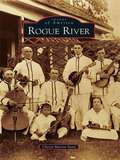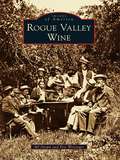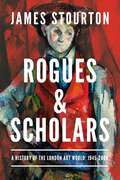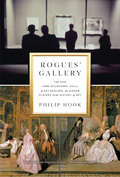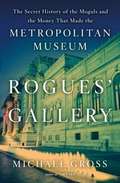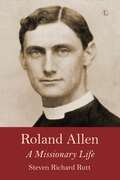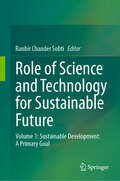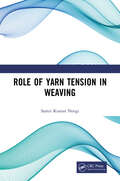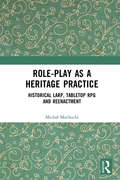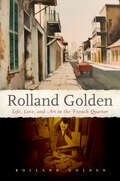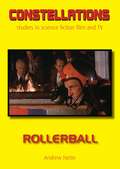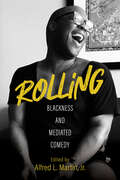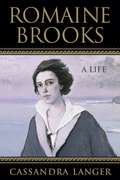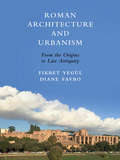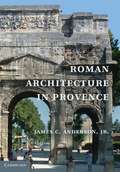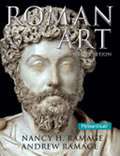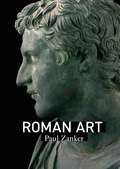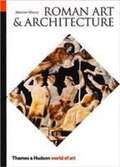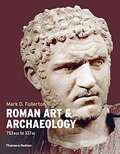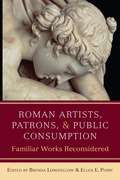- Table View
- List View
Rogue River (Images of America)
by Cheryl Martin SundThe town of Rogue River is a small community in southern Oregon located on the banks of the famous river for which it was named. Situated on Interstate 5, just 59 miles north of the California border, it lies between the cities of Grants Pass and Medford in the beautiful Rogue Valley. Founded in the midst of Native American wars and prolific gold mining, the town was originally called Tailholt before becoming Woodville. It incorporated and took its final name in 1912. A town proud of its accomplishments, it has nevertheless managed to preserve its history and maintain its small-town atmosphere and historical value, with many of the original buildings still in use. Along with sensational steelhead fishing, Rogue River is famous for its annual Rooster Crow festivities held on the last Saturday of each June.
Rogue Valley Wine (Images of America)
by Mj Daspit Eric WeisingerWinemaking in Oregon began more than 150 years ago when Peter Britt of Jacksonville brought grapevine cuttings from California to create his Valley View Vineyard. By 1890, the Southern Oregon State Board of Agriculture forecast a vineyard-dotted Rogue Valley to rival "the castled Rhine, the classical vales of Italy and the sunny slopes of France." But Prohibition, which became law in Oregon four years before the rest of the country, killed the nascent industry. Not until the 1970s, when Americans discovered a passion for wine, was winegrowing and winemaking in Southern Oregon's Rogue Valley reestablished. Pear orchards were converted to vineyards, and winemaking--not on a California scale, but rather in boutique wineries tucked away along scenic country roads--began anew and thrived.
Rogues and Scholars: A History of the London Art World: 1945-2000
by James StourtonA colorful and fast-moving account of how postwar London became the global center of the art market—a story of Impressionist masterpieces, dodgy dealers, and ground-breaking financial transactions.On October 15, 1958, Sotheby's of Bond Street staged an "event sale&” of seven Impressionist paintings belonging to Erwin Goldschmidt: three Manets, two Cézannes, one Van Gogh, and a Renoir. Kirk Douglas, Anthony Quinn, and Somerset Maugham were there as celebrity guests. The seven lots went for £781,000—at the time the highest price for a single sale. The event established London as the world center of the art market and Sotheby's as an international auction house. It began a shift in power from the dealers to the auctioneers and paved the way for Impressionist paintings to dominate the market for the next forty years. Sotheby's had pulled off a massive coup by capturing the Impressionist market from Paris and New York—and now began its inexorable rise, opening offices all over the world. A huge expansion of the market followed, accompanied by rocketing prices, colorful scandals, and legal dramas. London transformed itself from a fusty place of old master painting sales to a revitalized center of contemporary art, crowned by the opening of Tate Modern in 2000. The Tate Modern successfully united new (and mostly foreign) money in London with the art world, offering its patrons a ready-made sophisticated social milieu alongside dealers in contemporary art. In a vibrant and briskly-paced style, James Stourton tells the story of the London art market from the immediate postwar period to the turn of the millennium. While Sotheby's is the lynchpin of this story, Stourton populates his narrative with a glorious rogue's gallery of eccentric scholars, clever amateurs, brilliant emigrés, and stylish grandees with a flair for the deal.
Rogues' Gallery: The Rise (and Occasional Fall) of Art Dealers, the Hidden Players in the History of Art
by Philip HookHere for the first time is the history of art dealers, those extraordinary men and woman who, over centuries (and almost entirely out of the public eye), built their profession on a singular skill: identifying the intangible but infinitely desirable qualities that characterize the greatest works of art—and finding clients for whom those qualities are irresistible. Philip Hook’s riveting narrative takes us from the early days of art dealing in Antwerp, where paintings were sold by weight, to the unassailable hauteur of contemporary galleries in New York, London, Paris, and beyond. Along the way, we meet a surprisingly wide-ranging cast of characters—from tailors, spies, and the occasional anarchist to scholars, aristocrats, and connoisseurs, some compelled by greed, some by their own vision of art—and some by the art of the deal. Among them are Joseph Duveen, who almost single-handedly brought the Old Masters to America; Paul Durand-Ruel, the Impressionists’ champion; Daniel-Henry Kahnweiler, high priest of Cubism; Leo Castelli, dealer-midwife to Abstract Expressionism and Pop Art; and Peter Wilson, the charismatic Sotheby’s chairman who made a theater of the auction room.Rogues’ Gallery bursts with unforgettable anecdotes and astute judgments about art and artists, honed by Hook’s more than forty years in the art market—making it essential reading for anyone interested in the hidden history of art.
Rogues' Gallery: The Secret Story of the Lust, Lies, Greed, and Betrayals That Made the Metropolitan Museum of Art
by Michael Gross“Behind almost every painting is a fortune and behind that a sin or a crime.” <P><P> With these words as a starting point, Michael Gross, leading chronicler of the American rich, begins the first independent, unauthorized look at the saga of the nation’s greatest museum, the Metropolitan Museum of Art. In this endlessly entertaining follow-up to his bestselling social history 740 Park, Gross pulls back the shades of secrecy that have long shrouded the upper class’s cultural and philanthropic ambitions and maneuvers. And he paints a revealing portrait of a previously hidden face of American wealth and power.<P> The Metropolitan, Gross writes, “is a huge alchemical experiment, turning the worst of man’s attributes—extravagance, lust, gluttony, acquisitiveness, envy, avarice, greed, egotism, and pride—into the very best, transmuting deadly sins into priceless treasure.” The book covers the entire 138-year history of the Met, focusing on the museum’s most colorful characters. Opening with the lame-duck director Philippe de Montebello, the museum’s longest-serving leader who finally stepped down in 2008, Rogues’ Gallery then goes back to the very beginning, highlighting, among many others: the first director, Luigi Palma di Cesnola, an Italian-born epic phony, whose legacy is a trove of plundered ancient relics, some of which remain on display today; John Pierpont Morgan, the greatest capitalist and art collector of his day, who turned the museum from the plaything of a handful of rich amateurs into a professional operation dedicated, sort of, to the public good; John D. Rockefeller Jr., who never served the Met in any official capacity but who, during the Great Depression, proved the only man willing and rich enough to be its benefactor, which made him its behind-the-scenes puppeteer; the controversial Thomas Hoving, whose tenure as director during the sixties and seventies revolutionized museums around the world but left the Met in chaos; and Jane Engelhard and Annette de la Renta, a mother-daughter trustee tag team whose stories will astonish you (think Casablanca rewritten by Edith Wharton).<P> With a supporting cast that includes artists, forgers, and looters, financial geniuses and scoundrels, museum officers (like its chairman Arthur Amory Houghton, head of Corning Glass, who once ripped apart a priceless and ancient Islamic book in order to sell it off piecemeal), trustees (like Jayne Wrightsman, the Hollywood party girl turned society grand dame), curators (like the aging Dietrich von Bothmer, a refugee from Nazi Germany with a Bronze Star for heroism whose greatest acquisitions turned out to be looted), and donors (like Irwin Untermyer, whose collecting obsession drove his wife and children to suicide), and with cameo appearances by everyone from Vogue editors Anna Wintour and Diana Vreeland to Sex Pistols front man Johnny Rotten, Rogues’ Gallery is a rich, satisfying, alternately hilarious and horrifying look at America’s upper class, and what is perhaps its greatest creation.
Roland Allen: A Missionary Life
by Steven Richard RuttRoland Allen (1868-1947) is remembered as one of the foremost missionaries of the last century. Throughout his life, Allen travelled the world, following his vocation and building his missionary methods centred on a theology of indigenisation. From his early days as a Chaplain in China (during which Allen was forced to flee to the British Legation in Beijing), through to his continued mission to India, Canada and South Africa, he developed as man, missionary and theologian. The first of two volumes, Roland Allen: A Missionary Life is an intellectual biography which explores the people and ideas that influenced Allen while tracing the ways in which his missionary ecclesiology evolved during his life. Through extensive examination of unpublished archival papers, including lesser known letters and sermons, Steven Richard Rutt has uncovered the growth of a forthright, morally indefatigable churchman, who was also a loving family man with close and long-running friendships. Rutt unpacks Allen's Church-centred missionary ecclesiology and 'missiology of indigenisation', which were based on Allen's knowledge, gained from experience. Roland Allen: A Missionary Life and Roland Allen: A Theology of Mission explore the thought of a Christian whose writings provided farsighted clarity on global Christian missionary work that is still relevant today.
Role of Science and Technology for Sustainable Future: Volume 1: Sustainable Development: A Primary Goal
by Ranbir Chander SobtiThe book explores the pivotal role of science and technology in achieving the sustainable development goals (SDGs) outlined in the agenda 2030 for sustainable development. It emphasizes the importance of integrating science and technology into developing strategies to promote a sustainable and prosperous global future. The book highlights the universal acceptance of the SDGs by United Nations member states, subnational governing bodies, and international organizations. It emphasizes that all stakeholders, including governmental bodies, private enterprises, and civil society, have a responsibility to contribute to the achievement of the SDGs. Science, technology, and innovation are identified as the three pillars essential for achieving the SDGs. The book emphasizes the critical role of science and technology in addressing complex issues such as climate change, biodiversity loss, resource depletion, poverty reduction, health, education, gender equality, clean energy, sustainable cities, responsible consumption, and climate action. It helps to develop innovative solutions to promote economic growth, social inclusion, and environmental sustainability. And provide the necessary knowledge and tools to develop effective policies and strategies in these areas. Furthermore, the book highlights the potential of science and technology in promoting innovation and entrepreneurship, leading to the creation of new businesses and industries that align with sustainable development principles. This fosters economic growth, job creation, and environmental sustainability. It advocates for continued investment in science and technology and their integration into development strategies. The book aims to provide insights into the role of traditional and emerging areas of science and technology in meeting the goals outlined in the SDG document, with a specific focus on India. The book serves as a great source of information for researchers, teachers in basic and applied sciences /social sciences research and policymakers.
Role of Yarn Tension in Weaving
by Samir Kumar NeogiNo cloth can be woven without desired and adequate tensions of its constituent warp and weft yarns. This book explains the crucial role of yarn tension in weaving and discusses its various aspects and effects on cloth characteristics. The subject matter of this book includes – Yarn tension at the weaving preparatory process Warp tension measurement General form of weft tension variation Effects of loom settings and other factors on warp tension Effects of yarn tensions on loom performance Print edition not for sale in South Asia (India, Sri Lanka, Nepal, Bangladesh, Pakistan and Bhutan)
Role-play as a Heritage Practice: Historical Larp, Tabletop RPG and Reenactment
by Michal MochockiRole-play as a Heritage Practice is the first book to examine physically performed role-enactments, such as live-action role-play (LARP), tabletop role-playing games (TRPG), and hobbyist historical reenactment (RH), from a combined game studies and heritage studies perspective. Demonstrating that non-digital role-plays, such as TRPG and LARP, share many features with RH, the book contends that all three may be considered as heritage practices. Studying these role-plays as three distinct genres of playful, participatory and performative forms of engagement with cultural heritage, Mochocki demonstrates how an exploration of the affordances of each genre can be valuable. Showing that a player’s engagement with history or heritage material is always multi-layered, the book clarifies that the layers may be conceptualised simultaneously as types of heritage authenticity and as types of in-game immersion. It is also made clear that RH, TRPG and LARP share commonalities with a multitude of other media, including video games, historical fiction and film. Existing within, and contributing to, the fiction and non-fiction mediasphere, these role-enactments are shaped by the same large-scale narratives and discourses that persons, families, communities, and nations use to build memory and identity. Role-play as a Heritage Practice will be of great interest to academics and students engaged in the study of heritage, memory, nostalgia, role-playing, historical games, performance, fans and transmedia narratology.
Rolland Golden: Life, Love, and Art in the French Quarter
by Rolland GoldenIn the early twentieth century, the French Quarter had become home to a vibrant community of working artists attracted to the atmosphere, architecture, and colorful individuals who populated the scene (and who also became some of its first preservationists). Louisiana native Rolland Golden was one of these artists to live, work, and raise a family in this most storied corner of New Orleans. With 94 black-and-white and 54 color photographs and illustrations, his memoir of that life focuses on the period of 1955 to 1976. Golden, a painter, discusses the particular challenges of making a living from art, and his story becomes a family affair involving his daughters and his beloved wife, Stella.Golden's studio sat in a patio on Royal Street, around the corner from Preservation Hall where old-time musicians played Dixieland Jazz. Golden sketched and painted many of them in a visual style that encompassed realism and gradually developed into abstract realism. Golden recalls work that he did in historic preservation, sketching architecture for publications such as the Vieux Carre Courier, and he discusses his studies with renowned regionalist painter John McCrady. The artist frankly discusses his experiences with the display, representation, and sale of his work, presenting a little-explored and yet crucial part of a working artist's life. The memoir concludes with Golden and his wife traveling to the premiere of his exhibition in Moscow, having been selected by a Russian envoy as the only American artist to have a one-man touring exhibition in the former Soviet Union. Among the nearly 150 black-and-white and color illustrations are never-before-seen photos and sketches by the artist.
Rollerball (Constellations)
by Andrew NetteRollerball, the Canadian-born director and producer Norman Jewison’s 1975 vision of a future dominated by anonymous corporations and their executive elite, in which all individual effort and aggressive emotions are subsumed into a horrifically violent global sport, remains critically overlooked. What little has been written deals mainly with its place within the renaissance of Anglo-American science fiction cinema in the 1970s, or focuses on the elaborately shot, still visceral to watch, game sequences, so realistic they briefly gave rise to speculation Rollerball may become an actual sport.Drawing on numerous sources, including little examined documents in the archive of the film’s screenwriter William Harrison, Andrew Nette examines the many dimensions of Rollerball’s making and reception: the way it simultaneously exhibits the aesthetics and narrative tropes of mainstream action and art-house cinema; the elaborate and painstaking process of world creation undertaken by Jewison and Harrison; and the cultural forces and debates that influenced them, including the increasing corporate power and growing violence in Western society in late 1960s and early 1970s. Nette shows how a film that was derided by many critics for its violence works as a sophisticated and disturbing portrayal of a dystopian future that anticipates numerous contemporary concerns, including "fake news" and declining literary and historical memory. The book includes an interview with Jewison on Rollerball’s influences, making, and reception.
Rolling Thunder: A Century of Tank Warfare
by Philip KaplanThe tank is such a characteristic feature of modern warfare that its difficult to imagine a time when its presence wasn't felt on the battlefield in some form or another. Rolling Thunder, from eminent historian and author Philip Kaplan, traces the history of the vehicle from its developmental early days on the battlefields of the Great War, to modern-day uses and innovations in response to the growing demands of twenty-first century warfare.Featured in this volume are images of some of the most highly regarded and imposing types, such as the Chrysler-built Grant, the Skoda-built Hungarian Turan and the M-26 Pershing tank, employed so extensively during the Korean War. Tanks employed during the battles of Barbarossa, El Alamein, Kursk and Ardennes all feature, their histories depicted in words and images.From the battlefields of the Great War to modern-day theaters such as Iraq and Afghanistan, the history of this impressive war machine is tracked in detail.
Rolling: Blackness and Mediated Comedy (Comedy & Culture)
by Scott Poulson-Bryant Timothy Havens Ken Feil Jacqueline Johnson Gerald R. Butters Jr. Alfred L. Martin Jr. Lisa Guerrero Mel Stanfill Anshare Antoine Ellen Cleghorne Kelly Cole Phillip Lamarr Cunningham Felicia D. Henderson Joshua TrueloveSince slavery, African and African American humor has baffled, intrigued, angered, and entertained the masses.Rolling centers Blackness in comedy, especially on television, and observing that it is often relegated to biopics, slave narratives, and the comedic. But like W. E. B. DuBois's ideas about double consciousness and Racquel Gates's extension of his theories, we know that Blackness resonates for Black viewers in ways often entirely different than for white viewers. Contributors to this volume cover a range of cases representing African American humor across film, television, digital media, and stand-up as Black comic personas try to work within, outside, and around culture, tilling for content. Essays engage with the complex industrial interplay of Blackness, white audiences, and comedy; satire and humor on media platforms; and the production of Blackness within comedy through personal stories and interviews of Black production crew and writers for television comedy.Rolling illuminates the inner workings of Blackness and comedy in media discourse.
Rom Com
by Daniel Zomparelli Dina Del BucchiaAt precisely the cultural moment you were hoping for, a dream team of smart, sexy, brunette, West Coast poets of Italian descent has passionately co-authored an intelligent collection of poetry that both celebrates and capsizes the romantic comedy.From the origin of the genre (It Happened One Night) to its contemporary expressions (Love Actually), the poems in Rom Com trace the attempt to deconstruct as well as engage in dialogue with romantic comedy films and the pop culture, celebrities, and tropes that have come to be associated with them. These irreverent, playful, weird, and comedic poems come in a variety of forms, fully engaging in pop culture, without a judgmental tone. They see your frumpy expectations and raise you issues of sexuality, consent, sexism, homophobia, race, and class. They explore the highs and lows of romantic relationships and the expectations and realities of love, tackling real emotional worlds through the lens of film.Two cool people wrote it. Dina Del Bucchia, the fashionable and voluptuous, is a woman on the go, brazenly hosting literary events and tweeting about otters and award shows. Daniel Zomparelli, the handsome and dashing, is a young, gay man-about-Vancouver who somehow also quietly edits (in chief) a semi-annual poetry journal. (Ship them all you want, fools.)How to tell if you are compatible with this book: Are you equally versed in literature and pop culture? Are you a film-savvy fan of contemporary poetry? Are you an academic with interest in literature and cultural studies? Are you in general a cool, sad person? This book might just be the sassy best friend you've wanted.
Romaine Brooks: A Life
by Cassandra LangerThe artistic achievements of Romaine Brooks (1874-1970), both as a major expatriate American painter and as a formative innovator in the decorative arts, have long been overshadowed by her fifty-year relationship with writer Natalie Barney and a reputation as a fiercely independent, aloof heiress who associated with fascists in the 1930s. In Romaine Brooks: A Life, art historian Cassandra Langer provides a richer, deeper portrait of Brooks's aesthetics and experimentation as an artist--and of her entire life, from her chaotic, traumatic childhood to the enigmatic decades after World War II, when she produced very little art. This provocative, lively biography takes aim at many myths about Brooks and her friends, lovers, and the subjects of her portraits, revealing a woman of wit and passion who overcame enormous personal and societal challenges to become an extraordinary artist and create a life on her own terms. Romaine Brooks: A Life introduces much fresh information from Langer's decades of research on Brooks and establishes this groundbreaking artist's centrality to feminism and contemporary sexual politics as well as to visual culture.
Roman Architecture
by Frank SearFrank Sear traces the evolution of architecture during the four centuries from the late Republic, when Roman building came of age, to A. D. 330, when Constantine moved the empire's capital to Constantinople. More than 200 photographs, maps, and drawings illustrate a discussion ranging over the extent of the empire, from Italy and North Africa and to the European and eastern provinces. Sear elucidates the complex development of Roman architecture by studying in detail the one site he feels to be the most significant and representative of a given period or province and by placing each site in its historical and cultural context. Incorporating the latest archaeological findings, Sear treats much more than stylist innovations; he carefully considers the building methods and materials used by Roman architects and engineers, and he pays close attention to the conditions under which the buildings were erected. This updated edition of Roman Architecture includes a full bibliography.
Roman Architecture and Urbanism: From the Origins to Late Antiquity
by Diane Favro Fikret YegülSince antiquity, Roman architecture and planning have inspired architects and designers. In this volume, Diane Favro and Fikret Yegül offer a comprehensive history and analysis of the Roman built environment, emphasizing design and planning aspects of buildings and streetscapes. They explore the dynamic evolution and dissemination of architectural ideas, showing how local influences and technologies were incorporated across the vast Roman territory. They also consider how Roman construction and engineering expertise, as well as logistical proficiency, contributed to the making of bold and exceptional spaces and forms. Based on decades of first-hand examinations of ancient sites throughout the Roman world, from Britain to Syria, the authors give close accounts of many sites no longer extant or accessible. Written in a lively and accessible manner, Roman Architecture and Urbanism affirms the enduring attractions of Roman buildings and environments and their relevance to a global view of architecture. It will appeal to readers interested in the classical world and the history of architecture and urban design, as well as wide range of academic fields. With 835 illustrations including numerous new plans and drawings as well as digital renderings.
Roman Architecture in Provence
by James C. Anderson jr.This book provides a survey of the architecture and urbanism of Provence during the Roman era. Provence, or 'Gallia Narbonensis' as the Romans called it, was one of the earliest Roman colonies in Western Europe. In this book, James C. Anderson, jr. examines the layout and planning of towns in the region, both those founded by the Romans and those redeveloped from native settlements. He provides an in-depth study of the chronology, dating and remains of every type of Roman building for which there is evidence in Provence. The stamp of Roman civilization is apparent today in such cities as Orange, Nimes and Arles, where spectacular remains of bridges, theaters, fora and temples attest to the sophisticated civilization that existed in this area during the imperial period and late antiquity. This book focuses on the remains of buildings that can still be seen, exploring decorative elements and their influence from Rome and local traditions, as well as their functions within the urban environment.
Roman Art
by Nancy H. Ramage Andrew RamageRoman Art, 6/e helps students gain an understanding of the development of Roman art and architecture across the entire Roman empire. This title deals comprehensively with the architecture, sculpture, painting, mosaics, and the decorative arts of the Romans placing them in their proper historical context. Readers will examine these artworks in the context of the history, religion, and politics of each era, building a fuller picture of how the arts relate to what else is going on in the Roman Republic and Empire. <p><p> This title is ideal for readers who are studying Roman art for the first time. It assumes no prior acquaintance with the classical world, and explains the necessary linguistic, historical, religious, social, and political background needed to fully understand Roman art.
Roman Art
by Eve D'AmbraThe adjective "Roman" seems to sit more comfortably with political geography and historical development than with easily classified and recognizable works of art.
Roman Art
by Paul ZankerTraditional studies of Roman art have sought to identify an indigenous style distinct from Greek art and in the process have neglected the large body of Roman work that creatively recycled Greek artworks. Now available in paperback, this fresh reassessment offers instead a cultural history of the functions of the visual arts, the messages that these images carried, and the values that they affirmed in late Republican Rome and the Empire. The analysis begins at the point at which the characteristic features of Roman art started to emerge, when the Romans were exposed to Hellenistic culture through their conquest of Greek lands in the third century B.C. As a result, the values and social and political structure of Roman society changed, as did the functions and character of the images it generated. This volume, presented in very clear and accessible language, offers new and fascinating insights into the evolution of the forms and meanings of Roman art.
Roman Art And Architecture
by Mortimer WheelerSir Mortimer Wheeler describes the architecture and town planning, the sculpture and painting, the silverware, glass, pottery and the other rich artistic achievements of the era.
Roman Art and Archaeology
by Mark FullertonThe art of the Roman empire, in social and political context. <p><p> This new survey makes sense of Roman art by placing works in their full historical context—showing students not only how but also why art was used in Roman society and politics (such as wealthy Romans sponsoring public projects to promote themselves). The book breaks new ground by devoting chapters to art from the provinces, rather than focusing solely on Rome itself. Mark Fullerton provides the most in-depth look at Roman art from across the empire, connecting Roman art to the Mediterranean and the wider world.
Roman Artisans and the Urban Economy
by Cameron HawkinsThis book offers the first comprehensive study of economic conditions and economic life in Roman cities during the late Republic and early Empire. By employing a sophisticated methodology based upon comparative evidence and contemporary economic theory, the author develops interlocking arguments about the relationship between four key attributes of urban economic life in Roman antiquity: the nature and magnitude of consumer demand; the structure of urban labour markets; the strategies devised by urban artisans in their efforts to navigate their social and economic environments; and the factors that served to limit both the overall performance of the Roman economy, and its potential for intensive growth. While the author's methodology and conclusions will be of particular interest to specialists in economic history, other readers will profit from his discussion of topics such as slavery and manumission, the economic significance of professional associations, and the impact of gender on economic behaviour.
Roman Artists, Patrons, and Public Consumption: Familiar Works Reconsidered
by Brenda Longfellow Ellen PerryIn recent decades, the study of Roman art has shifted focus dramatically from issues of connoisseurship, typology, and chronology to analyses of objects within their contemporary contexts and local environments. Scholars challenge the notion, formerly taken for granted, that extant historical texts—the writings of Vitruvius, for example—can directly inform the study of architectural remains. Roman-era statues, paintings, and mosaics are no longer dismissed as perfunctory replicas of lost Greek or Hellenistic originals; they are worthy of study in their own right. Further, the scope of what constitutes Roman art has expanded to include the vast spectrum of objects used in civic, religious, funerary, and domestic contexts and from communities across the Roman Empire. The work gathered in Roman Artists, Patrons, and Public Consumption displays the breadth and depth of scholarship in the field made possible by these fundamental changes. The first five essays approach individual objects and artistic tropes, as well as their cultural contexts and functions, from fresh and dynamic angles. The latter essays focus on case studies in Pompeii, demonstrating how close visual analysis firmly rooted in local and temporal contexts not only strengthens understanding of ancient interactions with monuments but also sparks a reconsideration of long-held assumptions reinforced by earlier scholarship. These rigorous essays reflect and honor the groundbreaking scholarship of Elaine K. Gazda. In addition to volume editors Brenda Longfellow and Ellen E. Perry, contributors include Bettina Bergmann, Elise Friedland, Barbara Kellum, Diana Y. Ng, Jessica Powers, Melanie Grunow Sobocinski, Lea M. Stirling, Molly Swetnam-Burland, Elizabeth Wolfram Thill, and Jennifer Trimble.
